OPTIMISATION OF WATER RESOURCES
Better understand the soil / water relationship
by TurfPro Editor, Laurence Gale MSC, MBPR
One of the biggest problems facing many groundsmen is the ability to water their natural grass surfaces efficiently, during spells of hot dry weather.
We have certainly had a great start to the year, with many ground’s professionals enjoying the recent spell of record-breaking spring weather. This run of fine conditions has helped promote some much-needed grass growth and recovery on our natural grass playing surfaces.
This has been especially appreciated during the recent end of season and pre-season works of rugby football and cricket clubs. As we all know, the grass plant needs plenty of sunlight, water and nutrients to produce the quality swards we desire. I always find it amazing to see how we continue to improve the quality of our playing surfaces with the ever-ongoing technical advancements both in mechanical engineering, biological products and maintenance services.
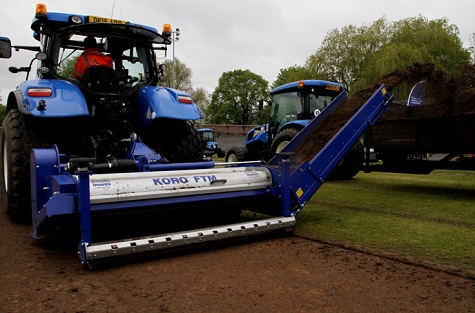
However, there is still one major factor that always dictates how we work and deliver these exceptional playing surfaces and that is the influence of the weather.
One of the biggest problems facing many groundsmen is the ability to water their natural grass surfaces efficiently, during spells of hot dry weather. The exception to this would be the high-profile professional football clubs, golf courses and top private sports facilities who have the budgets and resources to install effective irrigation systems.
Most if not all grass roots clubs and schools, do not have the means to water their pitches and rely heavily on the weather to provide enough essential water to keep the grass plant alive.
Phil Sharples , a renowned turf professional wrote an interesting article on grass growth and development which is well worth reading.
Having a better understanding of soil / water relationships is a key requirement when trying to grow and maintain grass playing surfaces. Over 90% of the water absorbed by the grass plant is lost through transpiration.
Most transpirational water loss occurs through the leaves, although some may occur through any plant part exposed to the atmosphere. The amount of water contained in a plant at any one time is only a small quantity absorbed and transpired. Nearly all the water lost from the turfgrass plant will be lost through the stomata on the leaves.
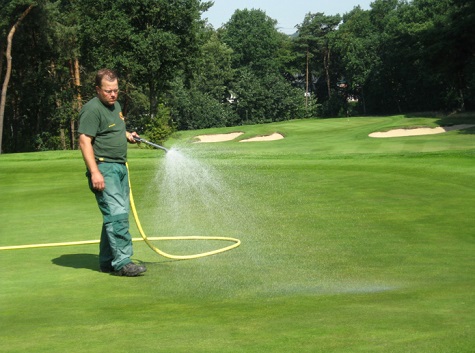
The stomata are important structures facilitating the gaseous exchange of CO2 and O2, so vital to photosynthesis. These same stomatal features that enhance efficient gaseous exchange also result in extensive water loss by transpiration. Although composing of only 2 - 3 % of the total turfgrass leaf area, the stomata are responsible for as much as 90% of the total water lost to the atmosphere by transpiration.
The loss of moisture from the soil is termed evaporation. As we have already discussed, loss of moisture from the plant is termed transpiration. Loss of moisture from both the soil and plant is termed Evapotranspiration. As much as 80 - 85% of the soil moisture depletion can be attributed to evapotranspiration.
Water has many important roles within plants and if the water content in the tissue should drop below 60%, the turf is seriously weakened and can die or go dormant. Water is not only essential for growth but necessary for conditioning turf to handle and recover from stress caused by heavy use and harsh environmental conditions.
Supplemental water is necessary when natural rainfall is not sufficient to keep turf healthy after the soils have dried out. Temperature, sunlight, wind, humidity and natural rainfall are climatic factors that help determine the amount of irrigation that is needed.
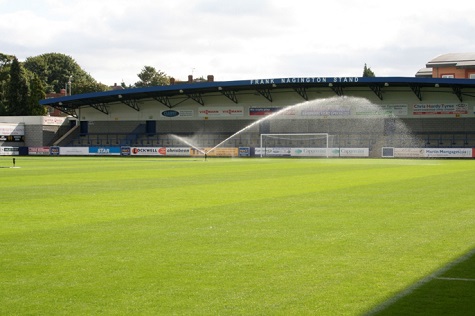
Having a better understanding of your soil texture (determined by the amount of sand, silt and clay in the soil) influences the amount of water that can be stored and available for plant use. For example, coarse textured soils such as sandy soils have poor water-holding capacity and will need to be watered more frequently than soils with more clay and organic matter which can hold more water.
Irrigation should be supplied to replenish the amount of moisture lost. Deep and infrequent watering, once or twice a week, is preferred unless you are on sand that needs more frequent irrigation.
Water in the early morning and late evenings when the wind is calm. Overwatering may lead to disease problems and thatch development.
Weather; air temperature, daylight hours, solar energy inputs, wind speed and shading are factors that will affect evapotranspiration rates.
Maintenance regimes; keeping the soil open and aerated will increase the drainage capacity of the soil. On the other hand, compacted soils will prevent the movement of water through soils, often creating an environment that prevents water getting down into the soil profile. By carrying out effective regular maintenance regimes that include aeration, scarifying, harrowing, brushing, top dressing all helps to keep the soil in good condition.
Groundsman/Greenkeeper knowledge; it is important that there is someone who understands all the above parameters and can access the water requirements of the turf and correctly implement the right irrigation schedule for the given sport/ facility.
There are three important levels of soil moisture content that reflect the availability of water in the soil. These levels are commonly referred to as: saturation, field capacity, and wilting point. When a soil is saturated, the soil pores are filled with water and nearly all the air in the soil has been displaced by water. The water held in the soil between saturation and field capacity is gravitational water. Frequently, gravitational water will take a few days to drain through the soil profile and some can be absorbed by roots of plants. Field capacity is defined as the level of soil moisture left in the soil after drainage of the gravitational water. Water held between field capacity and the wilting point is available for plant use. The wilting point is defined as the soil moisture content where most plants cannot exert enough force to remove water from small pores in the soil. Most turf grasses will be permanently damaged if the soil moisture content is allowed to reach the wilting point. In many cases, yield reductions may occur long before this point is reached.
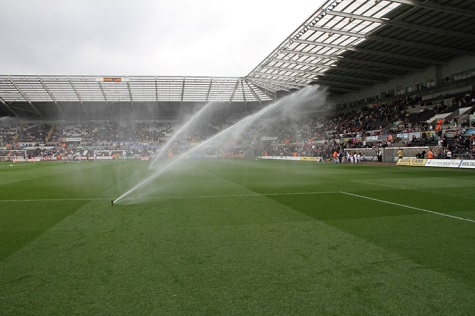
So, it is imperative you ensure your sward is kept watered to preventing it reaching wilting point. Today we have an array of techniques and aides to help measure the level of moistures in our soils. Soil water moisture probes or soil water meters can give us meaningful results that help us manage our irrigation needs.
We now also see a wider range of irrigation systems available, from stand alone, self-travelling or boom sprinklers to computer controlled high-tech pop-up gear driven or jet sprinkler systems able to deliver precise amounts of water. Many of the top golf courses have what is called wall to wall irrigation systems designed to irrigate greens, tees, approaches and fairways, enabling the course manager to have full control of his watering requirements.
These systems do use a lot of water, albeit more effectively, so consideration needs to be given to the resource available. Is it mains, borehole, well, river or lake water? In most instances an abstraction licence will be required to obtain this water even though the source may be on club owned land. Irrigation constitutes a major user of water resources at times, and in places, when resources are often at their lowest, such as the summer. Incorrect use of irrigation can lead to a waste of water and, in turn, can cause other problems such as increased drainage water, often resulting in the leaching of nitrates into watercourses with the possibility of pollution.
In recent years the government have introduced a number of laws and regulations regarding the use of water resources. The Water Resources (EIA) Regulations 2003 dictates several issues regarding the use of water, of which the Environment Agency is the main governing body associated with policing the use of water in the UK - along with other agencies such as DEFRA (Department for Environment Food and Rural Affairs). These new laws and regulations will have a significant impact on the way we use and utilise water in the future.
Irrigation management and the optimisation of watering strategies are important to the proper maintenance of sports facilities. Insufficient moisture when soils reach a water deficit will result in a declining quality of sward, or even death. Legislation is going to force the industry to control and manage this scarce resource, therefore the understanding and implementation of an irrigation strategy is a must for all clubs and organisations.
 |
|
 |  |
MASTER GREENKEEPER RECORD SET
Six of the best
BIGGA have announced that a record number of members have achieved the Master Greenkeeper certificate following examinations in April.
Read more
The British and International Golf Greenkeepers Association (BIGGA) have announced that a record number of members have achieved the Master Greenkeeper certificate following examinations in April.
The six BIGGA members have joined the ranks of course managers, head greenkeepers and superintendents who can count themselves among the most highly-qualified and respected individuals within the industry.
First awarded in 1991, the Master Greenkeeper Certificate is awarded to those BIGGA members who have reached the highest standards of greenkeeping and golf course management.
To be eligible, a BIGGA member must have spent at least 10 years working in greenkeeping, with a minimum of three in a head greenkeeper, course manager or superintendent role. They must also have been responsible for their current golf course or courses for a minimum of two years.
The successful BIGGA members who achieved Master Greenkeeper status are:
- Bob Vaughey, Rolling Hills Country Club, California, USA;
- Sam Evans, Fulwell Golf Club, UK;
- Rob Clare, Brough Golf Club, UK;
- David McGregor, Westwood Country Club, Virginia, USA;
- Matthew Gourlay, Colbert Hill Golf Course, Kansas City, USA;
- Andrew Sprunt, Florissant City Golf Course, Missouri, USA.
In achieving the certificate, Andy has become BIGGA’s 80th Master Greenkeeper.
For Matthew Gourlay, golf is a family business. His grandfather emigrated to Canada from Scotland in 1948 and was a founder member of the Canadian Golf Superintendents Association, while the family name is synonymous with the feathery golf balls that were popular in Scotland in the first half of the 19th Century.
Matthew said: “I have always thought highly of the Master Greenkeeper Certificate, having worked for Steve Cook CGCS MG. But it wasn’t until attending BTME for the first time in 2016 and watching a mentor, Matt Wharton CGCS MG, being recognised that I made it a goal of mine. I attended that show with Tony Girardi CGCS MG and we both walked away with a huge appreciation of the rigorous standards needed to achieve this designation. We both set forth with the goal of achieving the MG certificate, with Tony obtaining his last year.
“I just enjoy continuing to learn about the golf industry. After achieving the MG certificate, I am asking myself, ‘what’s next?’ as I believe in setting goals. Goals help me achieve the highest potential, they make me stretch beyong my normal self and reach new heights.”
Sam Evans, course manager at Fulwell has achieved the accreditation aged just 30. An active member of BIGGA, Sam has participated in two Open volunteer support teams, the Future Turf Managers Initiative, the TPC Sawgrass volunteer programme and the BIGGA Delegation to the Golf Industry Show.
He said: “I wanted to do the Master Greenkeeper Certificate as I believe there is always a next level to aspire to and push yourself to. I have been brought up to aim high and, to me, the Master Greenkeeper certificate is an unrivalled pinnacle of professional status, which I still can not believe I have achieved. I am over the moon to be awarded this and it is another example of how hard work really does pay off.”
 |  |
GLEANEAGLES INVEST IN GREENKEEPING TALENT
Stephen Lindsay joins
The world-famous hotel and sporting estate continues to build one of the finest greenkeeping teams with the announcement Stephen Lindsay has joined as first assistant.
Gleneagles, the world-famous hotel and sporting estate, continues to build one of the golf industry's finest greenkeeping teams with the announcement Stephen Lindsay has joined the team as first assistant.
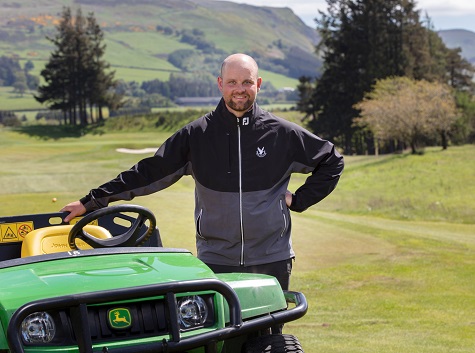
Stephen Lindsay
Stephen headed to Perthshire after spending four years at Wentworth Club in Surrey, where he was deputy head greenkeeper, responsible for the conditioning of the world-famous West Course, host venue of the European Tour's BMW PGA Championships.
Prior to this, Stephen's experience spans work at Cape Kidnappers Golf Course, New Zealand, Ohio State University internships at Harbour Town Golf Links and Hilton Head Island, USA, and tournament preparation work for the 2014 Wells Fargo Championship and 2017 PGA Championship.
Stephen's appointment coincides with final preparations for hosting the Solheim Cup on the Jack Nicklaus-designed PGA Centenary Course in September, following on from the 2014 Ryder Cup, making Gleneagles the only venue in Europe to stage both Matches.
Craig Haldane, Golf Courses Manager, who himself joined Gleneagles after hugely successful periods in Dubai, Bahrain, Indonesia and his native South Africa, said: "Our primary objective is to condition our championship courses to ensure every person, whether they be a tournament professional, a Gleneagles member or visitor, has a world-class golf experience.
"Stephen’s arrival, coupled with his expert knowledge, industry insights and global greenkeeping experiences are already proving to be a valuable addition to our growing team, especially as we conclude some important enhancements to our iconic Queen's Course, and make final preparations for the Solheim Cup."
Gleneagles is also currently celebrating the centenary of its James Braid-designed King's and Queen's golf courses. Both courses, The Queen's initially opening as a nine-hole design, have become iconic destinations for golf lovers, connoisseurs and sporting celebrities the world over, and have benefited from extensive restoration projects that started in 2016.
The important work took inspiration from archived photographs and Braid’s original designs and saw fairways widened, bunkers sympathetically restored, and the re-introduction of Scottish heather to better frame all playing surfaces.
Recognising the successful completion of this work, the golf courses have gone on to win a host of important accolades, including, No.1 Golf Resort in the UK and Ireland (Golf World, 2017); Best UK Golf Resort 2018 (Square Mile); Best Golf Resort in the World for seven consecutive years (Daily Telegraph Ultratravel ULTRAS Awards, 2012-2018).
 |  |
SEARCH TO FIND ‘UK’S BEST PARK’
Launched by Fields In Trust
Award is open to all public green spaces across the UK through an online nomination.
UK-wide green space charity, Fields in Trust, has launched a campaign to find the UK’s Best Park.
The competition is open to all public green spaces across the UK through an online nomination at www.fieldsintrust.org/best-park

Having first been awarded in 2015, the UK’s Best Park Award returns this year in a new summer time-slot which sees it form part of Fields in Trust’s ‘Summer of Parks’.
Chairman of Trustees at Fields in Trust, Tim Phillips, said, "Parks and green spaces are not simply nice to have, they are a necessity for healthy happy communities, positively impacting on a range of key wellbeing issues from physical and mental health to social cohesion.
"This Award recognises the vital role that local parks play in our neighbourhoods, bringing people together and creating places for play, sport and the enjoyment of nature; places that should be protected for everyone. We want to celebrate these much-loved green spaces and invite all park users to vote for their favourite.”
Nominations for the UK’s Best Park open as Fields in Trust publish new research. The Green Space Index reveals that over 2.5 million people across Great Britain live more than ten-minutes-walk from their nearest park or green space. The charity has developed the Green Space Index which, for the first time, uses new Ordnance Survey data to comprehensively analyse park and green space provision across Great Britain.
 |  |
JOHN DEERE AWARD TOP APPRENTICES
31 young service technicians formally graduate
Apprentice of the Year for 2018 was Henry Smith of Cornthwaite Agricultural Ltd in Ormskirk.
A total of 31 young service technicians have formally graduated from the latest John Deere Ag Tech and Turf Tech advanced apprenticeship programmes, which are run in partnership with national training provider ProVQ at the purpose-built John Deere Apprentice Training Centre in Radcliffe-on-Trent, Nottinghamshire.
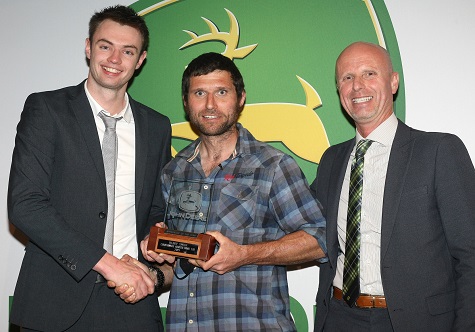
Guy Martin (centre) and ProVQ chairman Julian Lloyd (right) presented the John Deere Apprentice of the Year award to Henry Smith of Cornthwaite Agricultural Ltd, Ormskirk
Apprentice of the Year for 2018 was Henry Smith of Cornthwaite Agricultural Ltd in Ormskirk, who received a crystal plaque, winner’s certificate and a John Deere tool kit worth £500. The runners-up were Martyn Burnett of HRN Tractors Ltd, Insch and William Storr of Rea Valley Tractors, Sudbury, who each received a certificate and high street vouchers worth £250.
The annual apprentice graduation ceremony was held at the East Midlands Conference Centre on the University of Nottingham campus for the first time, with the students’ parents and dealer representatives also invited to celebrate the occasion. John Deere Limited managing director Jonathan Henry presented the apprentices with their graduation certificates, while after-dinner guest speaker and TV presenter Guy Martin, together with ProVQ chairman Julian Lloyd, handed over the three apprentice of the year awards.
These awards are based on the trainees’ consistently high standards of work, both at their dealerships and at the training centre, over the three years of the apprenticeship. In addition, all central government approved apprenticeships in England now require an end-point assessment, over and above the log of work progress that was kept for each apprentice before last year. The majority of the 2018 graduates were therefore the first John Deere technicians to qualify under the new EPA rules.

John Deere’s latest qualified Ag Tech and Turf Tech apprentices, with training centre manager Allan Cochran and managing director Jonathan Henry, at the 2018 graduation year presentation ceremony in Nottingham in April
“With the new EPA tests, which were held at Langar in April, both John Deere and our dealers are now able to quantify more effectively the skills of the apprentices we are training,” says John Deere Limited training centre manager Allan Cochran. “An EPA pass mark of above 90 per cent was required to earn a distinction and well over half the apprentices we tested achieved this, which was well above our initial expectations, so we have got off to a great start with these new assessments.”
John Deere’s three-year Ag Tech and Turf Tech and two-year Parts Tech apprenticeships involve students being trained in engineering, electronics, hydraulics, diagnostics, communication skills, computing, sales and marketing. The programmes lead to IMI Level 2 & 3 Diplomas in Landbased Engineering and Vehicle Parts Competence, and registration at LTA Intermediate level in the industry’s Landbased Training Accreditation scheme.
In subsequent years qualified technicians undergo further education and adult training within the John Deere University programme, on a career path that can ultimately lead to the highest possible LTA Master Technician accreditation.
New student intakes are in September each year; apprentices need to be resident in the UK, sponsored by a John Deere dealer and aged 16 or over. The standard programmes include on-the-job training and assessment as well as eight weeks each year at the John Deere Apprentice Training Centre. Further details can be found here.
Now in its 27th year, Ag Tech was the first such scheme to be introduced in the UK and won a National Training Award at the end of 1997, the only one ever made to an agricultural machinery apprenticeship programme. Since the first programme started in 1992, over 750 apprentices have graduated through the three main schemes and are now working in the company’s nationwide dealer network.
John Deere’s 2018 graduate apprentices, plus their sponsoring dealers, are:
Ag Tech - James Rudolph & Callum Truman, Ben Burgess & Co, Coates; George Bye, Ben Burgess & Co, Newmarket; Luke Crowhurst, Burden Bros Agri, Stockbury; Henry Smith, Cornthwaite Agricultural, Ormskirk; Martyn Burnett, HRN Tractors, Insch; Oliver Rabjohns, Masons Kings, Exebridge; Hari Lloyd, Mona Tractor Co, Criccieth; Louie Waddingham, Rabeys Garage, Guernsey; Kyle Hickson, RBM Agricultural, Brigg; Matthew Simkins, Rea Valley Tractors, Newport; William Storr, Rea Valley Tractors, Sudbury; Joshua Pacey, Sharmans Agricultural, Grantham; Edward Leech, Sharmans Agricultural, Lowdham; Matthew Morley Lamb, Sharmans Agricultural, Melton Mowbray; Cole Sansom, Sharmans Agricultural, Stamford; Toby Cutler, C Smart Agricultural Services, Dorchester; Jake Williams, Frank Sutton, Bridgend; Michael Mitchell, Frank Sutton, Raglan; Stuart Gallop, Tom Legge & Louis Williams, Tallis Amos Group, Evesham; Cennydd Hughes, Tallis Amos Group, Narberth; Kieran Armstrong, Thomas Sherriff & Co, Haddington; Kevin Wilson, Thomas Sherriff & Co, Jedburgh; Seb Marno, P Tuckwell, Ardleigh; George Spackman, P Tuckwell, Great Dunmow; Richard Chennells, P Tuckwell, Maulden; Sam Winch, P Tuckwell, Rayleigh; and Sam Thompson, P Tuckwell, Woodbridge;
Turf Tech - Tom Wombwell, Masons Kings, Chudleigh.
 |  |
JENSON ENJOYS ARB SHOW SUCCESS
Large number of demos booked
The team behind the UK distribution of Jensen woodchippers say they were delighted to host a stand at the 2019 Arb Show recently, supported by dealers Riverlea.
The team behind the UK distribution of Jensen woodchippers say they were delighted to host a stand at the 2019 Arb Show recently, supported by dealers Riverlea.
With a prominent stand overlooking the entrance, the woodchippers were on full display to several thousand visitors that attended over the course of the two-day event, drawing in crowds of interested people and resulting in a large number of demonstration bookings throughout the country.
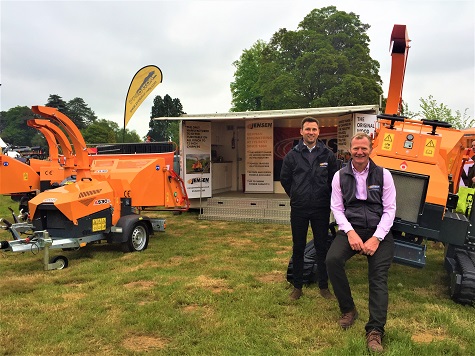
Bill Johnston and Nathan Jacobs of Jensen UK at the Arb Show 2019
A wide variety of Jensen machinery was available to see at the show, including towed and tracked machines, having both petrol and diesel models on display.
"This is the third year we’ve attended the Arb Show with Jensen and we were delighted with not only the turn out to the event but the huge level of interest in the brand”, says Bill Johnston, head of T H White Machinery Imports division and business manager for Jensen in the UK.
"It was excellent to meet a large number of existing Jensen owners who were pleased to share their experiences with us, as well as a whole host of new customers booking on-site demonstrations.
“We’re looking forward to seeing lots of those visitors again over the coming weeks, giving them the opportunity to try a Jensen for themselves and experience the power and performance of the world’s original woodchippers.”
The Jensen dealer for Wales, Riverlea, supported the stand at the show and was represented by sales manager Paul Austin.
“This was my first time at the Arb Show and I found it very interesting," said Paul. "We were pleased to speak to visitors and leave at the end of the show with some leads, which I hope will generate some more sales for Jensen over the coming months.”
 |  |
DGM DELIVER VENTRAC & SISIS PACKAGE
To Merlin Golf Course
Cornish golf club praises machinery investment, facilitated by local dealer Devon Garden Machinery
One of the latest golf clubs in the west country to invest in Ventrac equipment is Merlin Golf Course on the north Cornish coast. Situated on high ground close to Mawgan Porth and only a short drive from Newquay, this heathland course enjoys stunning views towards the Atlantic Ocean.
This latest package, delivered by local dealer Devon Garden Machinery, included a Ventrac 4500 compact tractor unit with Contour mowing deck and a Sisis Multitiner 1200.
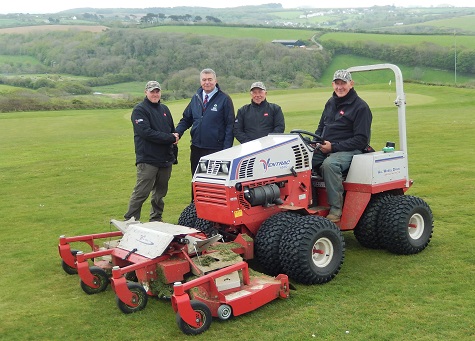
DGM’s Vic Robinson (second left) congratulates course manager Martyn Bennett on the purchase of the Ventrac package, alongside Rob Hall and Carl Quible of the greenkeeping team
Martyn Bennett is the Course Manager and is assisted by two long-serving greenkeepers, Rob Hall and Carl Quible. He joined Merlin just 8 months ago after four years as deputy course manager at Caversham Heath Golf Club in Berkshire and before that spent 12 years at Basingstoke Golf Club in Hampshire.
“We were in the market for a new rough mower and my predecessor had a demonstration back in July 2018,” he said. “We had a further demonstration when I arrived, so I could confirm that it would be suitable for the course and I wasn’t disappointed. It’s remarkably powerful for a sub-25 hp tractor, quiet and produces an excellent stripped finish with no mess. We used gang mowers previously so this has been a revelation. It’s so manoeuvrable and has reduced our fuel bills for maintaining the rough by 50%; that’s a significant saving."
Carl Quible is the principal operator of the machine and says, “We have some extreme slopes around the course and I feel 100% safe when I’m mowing. It enables us to maintain the banks on a regular basis and can go where other mowers cannot go. It’s a powerful compact machine and has certainly enhanced the presentation of the course."
 |  |
TURFPRO LAUNCH NEW WEBSITE
In support of Weekly Briefing
TurfPro has launched a modern new website where readers can catch up on blogs, features and news.
TurfPro has launched a modern new website where readers can catch up on blogs, features and news.

www.turfpro.co.uk is the place where readers can also find an archive of this Weekly Briefing, details about forthcoming industry events, who we are and how to get in contact with us - as well as details on how to advertise with TurfPro.
Editor, Laurence Gale said, "The website is in-keeping with the style of our sister magazine, Service Dealer's website - and is a very welcome addition to our online portfolio.
"I hope our readers will enjoy its clear modern, styling, which will allow them to easily to locate a blog or feature from the Weekly Briefing which they wish to return to."
|
 |  |
ADVERTISE YOUR JOBS HERE
Amazing success rates!
Advertise your recruitment needs on TurfPro Weekly Briefing and reach our targeted audience of recipients every week.
Contact Nikki Harrison for details - 01491 837117
|
 |  |
 |  |
 |  |
 |  |
 |  |
UNDER PRESSURE
Dry weather conditions continue to keep turf managers focused on moisture management
by Alastair Higgs, Golf District Manager – UK, Rain Bird Europe
While you can’t control weather, there are steps you can take to conserve water, to maximise the impact of any you apply, and control consumption.
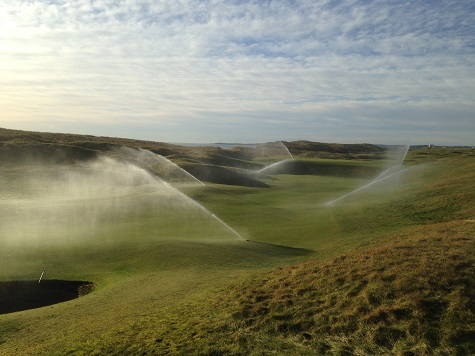
Irrigation on 6th fairway - credit Royal Aberdeen Golf Club
As tabloid press headlines predict a ‘flaming June’, consumers, industry and environmentalists acknowledge the incredibly dry winter and spring experienced in many areas. The Met Office revealed last week that average rainfall during May was around 45% of what’s usually expected. This adds pressure for turf managers and their teams still dealing with the after-effects of last year’s record-breaking heatwave.
When you can no longer rely on the weather to provide the water your turf needs, irrigation system efficiency and moisture control are crucial. While you can’t control weather, there are steps you can take to conserve water, to maximise the impact of any you apply, and control consumption. This, in turn, puts you in a position to react and adapt when conditions change.
Here’s some advice for making the most of every drop.
- From an agronomic and a financial perspective, it’s important to monitor water consumption. You might know how many minutes your system is running for, but what volume is being applied? This can be monitored, real-time alongside electricity being used.
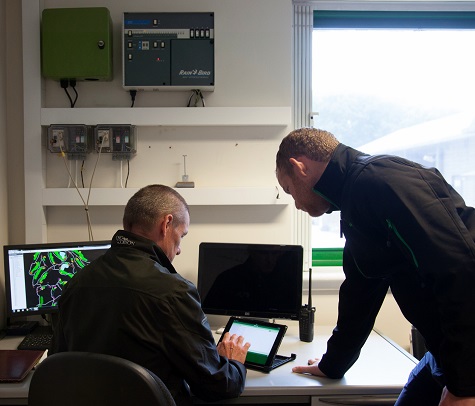
- Monitor evapotranspiration rates and apply only the amount of water needed for plant health.
- Even small environmental or mechanical changes can mean irrigation is ineffective. Are dry areas getting the volume of water you think they are? Is there high distribution uniformity (DU)? Is all the water applied actually being used, or is some being wasted because soak time hasn’t been factored in?
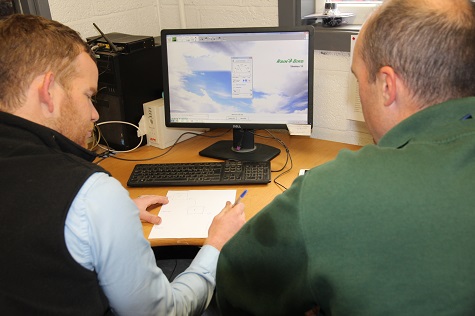
- Ensure all irrigation zones or areas are consistent; don’t mix and match nozzle or rotor types in a zone when you’re replacing them if you can avoid it and, set rotors to deliver the correct volume of water in a uniform way. Incorrectly set rotors can result in loss of performance of up to 60%.
- Are certain areas of your course or site regularly hand-watered? A before-and-after audit on these will ensure the correct set up. Turf managers taking time to assess and adjust irrigation practices report a 40% reduction in hand-watering as a result and a reduction on overall run times from superior DU.
- Monitor soil moisture levels regularly with accurate soil moisture sensors so you can irrigate to target volumetric water content (VWC) in each zone.

- Reduce leaks with detection technologies. Monitor theoretical flow on the course against actual pump flow and keep adjusting for optimal efficiency. Ensure infield equipment works properly. Shorten irrigation windows to maximise maintenance and golfing time.
- Monitor water storage in real-time to make fully informed irrigation decisions and not run dry.
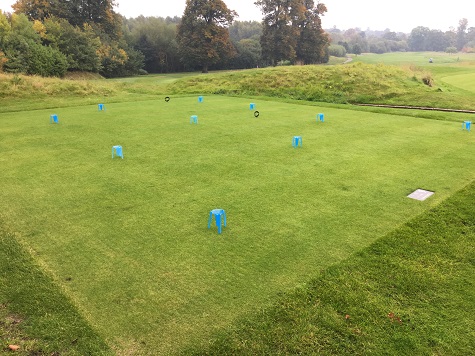
- Set aside time to manage irrigation and keep your system running as it should be. Conduct regular maintenance audits in the pump house and on rotors. Keep an irrigation diary, logging faults or alterations that need to be tackled at a later date. Gather data that demonstrates the importance of regular maintenance and consistent monitoring.
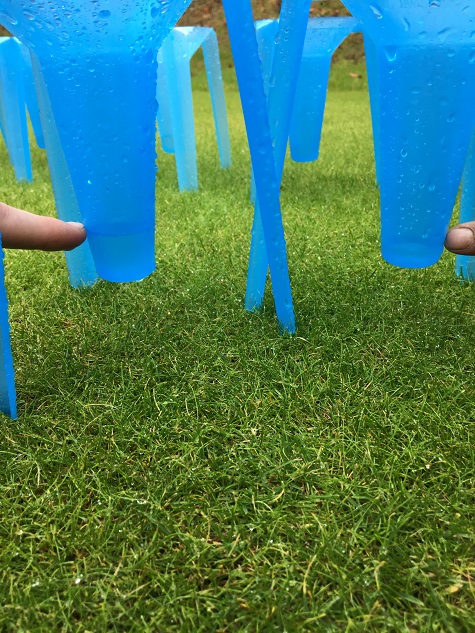
Weather patterns and expert long-term predictions suggest that our industry must proactively plan for the future and take action. If your system is ageing, contact us, our distributors or your contractor, about upgrading or replacing it. Upgrading can be inexpensive and carried out in discreet stages, each providing agronomic and efficiency benefits. Replacing a system can seem a daunting prospect, but we can help you get the planning underway and expertly guide you and your employer through the process.

Alastair Higgs (Golf) - ahiggs@rainbird.eu
Peter Longman (Turf & Landscape) – plongman@rainbird.eu
 |
|
|
|